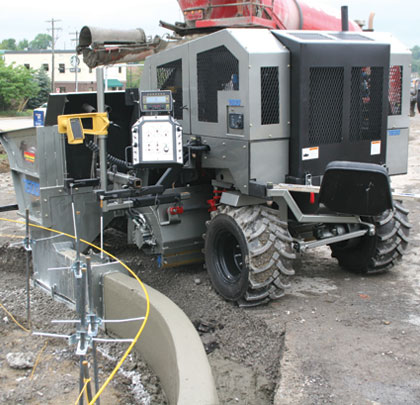A recent retrofit of a parking lot on the West Virginia University campus in Morgantown, West Virginia, was anything but ordinary. To do the curb work cost-effectively, the contractor would have to maintain a precise curb height amid tight radiuses and reach down below the existing asphalt pavement 14 to 16 inches into a deep ditch to construct the curb. The project would require special equipment.
The parking lot was scheduled to be retrofitted in fall 2012. The process involved cutting out the old asphalt, preparing the subbase, and constructing a new curb. In northern climates, it is particularly important to construct the curb far below grade, below the frostline.
THE PROJECT SCOPE
This project was a $1.2 million retrofit of a 6-acre parking lot, which included three bioretention areas, drainage work, base course, and wearing course asphalt for the existing parking lot and an addition of 1,200 lineal feet of curb. Green River installed a 20-inch curb, 14 inches below the existing surface, and left 6 inches exposed. To do the curb work, the contractor used a newly purchased Phoenix 7500 slipform curb machine equipped with a Topcon System Five grade control system.
Maneuverability and precise grade control were paramount on this project and Green River would need this advanced equipment to tackle it. For one, the contractor was to install curbing in and around an existing parking lot where the asphalt had to be cut down and back 4 to 6 inches from the face of the new curb to make room for installation. The sheer height of the 20-inch curb promised to pose a challenging placement. The machine would have to maneuver over multiple surfaces and ditches without collapsing pavement; the job was characterized by tight radiuses. Last but not least, the project supervisor, Donnie Hawkins, had just 1 day of training on the 7500 prior to the project.
RISE OF THE PHOENIX
The Phoenix 7500 was developed to be the first midsize slipform curb and gutter machine. The key feature of the machine that allows automatic paving of radius curb is a trimmer that is located only a foot ahead of the machine pivot point, in contrast to larger machines that have trimmers located 5 to 6 feet behind the mold. The Phoenix 7500 has a tight radius sensor that is located about 18 inches from the back of the machine and tracks the tight radiuses in automatic.
For the university parking lot, the under-10,000-pound machine was delivered to the site on a flatbed trailer pulled by a 1-ton truck. The machine was ready for operation in 30 minutes. The rubber tires were suited to this project because the machine had to travel very close to where the asphalt was cut down to the new curb without collapsing the asphalt. Additionally, the rubber tires eliminated the need for rubber tracks that are typically used to prevent damage to the asphalt.
The System Five, a standard feature on the Phoenix 7500, maintained the height and cross-slope of the curb work. The system is equipped with a slope sensor designed to allow slope capabilities up to 100 percent. On this project, the grading system allowed Green River to place curb while turning, going uphill, and leveling against different pitches on the roadway.
“You still have to set stringline, but the sonic senses the stringline height and you can dial that up or down and then it automatically controls off of that stringline,” says Ed Taylor, the machine’s inventor, adding that real-time elevation adjustment capability via the control panel paid off on the West Virginia project.
TACKLING THE OBSTACLES
The curb placement was characterized by several obstacles. For instance, several concrete light bases were located only about an inch from the curb and Green River had to place concrete around them. To do this, the contractor had to swing the sonic sensor away from the stringline, which caused signal loss. The finished curb work did not show any variation in elevation next to the light bases, though. For corner work, the hopper’s 20-inch lift came in handy. The machine slipformed curb up to a corner and backed up, leaving a 90-degree curb for the next section that was placed at a right angle. The machine could then back up to within about a foot of the last placement and resume slipforming.
Large curb machines would not be able to negotiate corners in the same way, Taylor points out. They could pull to within 10 to 20 feet of the end of the curb. “And then, to try and back in a corner, number one, they won’t do the tight radiuses, and number two, you can’t back up close enough to really make it worthwhile,” he says. “So, it was really an ideal job for our 7500 and the Topcon system made it that much easier.”
As it happened, Green River placed an average of 10 feet of curb per minute, although the curb work did not occur continuously, and completed the project in 5 days, including the day of training for Hawkins. Only one other worker was needed, communicating with the ready-mix concrete truck driver from the front of the machine.
Hawkins came away impressed with the equipment he used. “That was as perfect a curb as you’ll ever find, performed on time, under budget, and with fewer labor costs,” he says. ■
About The Author:
Don Talend of Write Results Inc. in West Dundee, Illinois, is a print and digital content producer specializing in covering construction and geospatial topics.
_________________________________________________________________________
Modern Contractor Solutions, May 2013
Did you enjoy this article?
Subscribe to the FREE Digital Edition of Modern Contractor Solutions magazine.

Curbing Impediments to Efficiency


